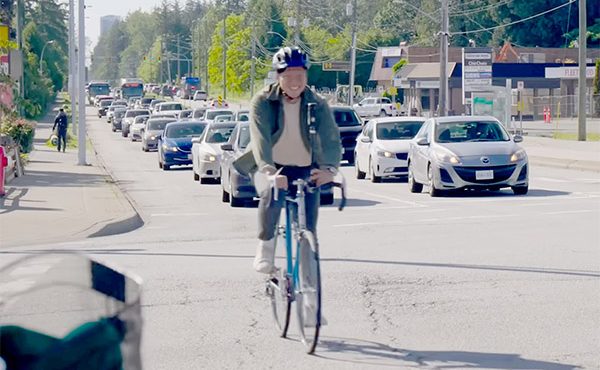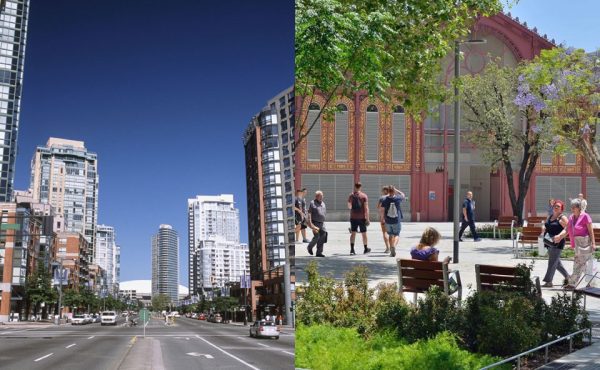

On October 5th, Maclure’s celebrated 100 years of operation as a taxicab business in the Lower Mainland. Those 100 years have seen a great deal of change in how we get around in Vancouver — from walking and cycling, to horse-drawn carriages, to streetcars, to, more recently, electric trolley buses, diesel buses, and cars big and small.
While we can look back on it purely with nostalgia, we can also think about it through the lens of a sustainable urban transportation future, that involves single-occupancy vehicles and more of other modes that both emit fewer GHGs and keep us engaged with our communities. How might we draw upon our past to inspire us in creating what comes next?
Back to the Future
When MacLure’s first started, taxicabs were offering rides on a street like the one you see in the video embedded below. William Harbeck’s film was shot from a camera mounted on the front a streetcar in 1907, as it traversed what is now Downtown Vancouver:
A sustainable transportation future is likely to have some elements of the street in that video clip, along with some of what we have got currently. Ideally, we want to combine what worked before with what we know and want now — like safety, street life, and social inclusion. Taxicabs are a business model which persisted through the streetcar and automobile cities. That means that there is something about it that works and fulfills our needs…but just what is that?
Taxis in Vancouver Now
Taxis provide a pretty similar service now that they always have, even as our alternatives and expectations for getting around the city have changed dramatically. Currently, taxicabs provide for people with disabilities; visitors to the city; those of us who cannot drive due to temporary circumstances like injury, emergency or inebriation; or, at a more basic level, for those times when we don’t want to drive, and don’t want to deal with the stuff that comes along with driving. Their inherent value is in their flexibility.
We can see this flexibility in other options available, such as car sharing services (like ZipCar or Vancouver’s local car co-op Modo) or bicycle sharing systems which have been popular in cities worldwide and continue to grow.
These services and models, like the taxicab business model, speak deeply to the idea that mobility within the urban lifestyle — which fully encompasses living, working and thriving in the urban environment — works best when it is a multi-modal affair. Painting our mobility challenges with a single default-travel-mode brush — whether that mode is bike, transit or cars — is, at best, ineffective, and at worst, overly reductive, inefficient and (for cars especially, with gas, maintenance and parking prices starting to reflect their true collective cost) increasingly expensive.
Mobility in the World of Tomorrow?
Here are just four examples of the many tools under development which continue to create ever-more hybrid options of the taxicab, ride-sharing and car ownership-access models. The first two, TaxiNow and Weeels, make use of existing taxicab services as they already exist, while the latter two, Avego and RelayRides, mash the ride-sharing and car-sharing experiences respectively with the standard car ownership model.
TaxiNow
The project of a local Vancouver start-up, TaxiNow is a clever iPhone app that connects taxi cab drivers available for rides with people looking for cabs, by allowing each to broadcast their location and to call each other immediately. See some additional thoughts on what it’s like to use this app in Toronto. (Thanks to Cathy Browne for point this app out to me!)
Weeels
Based in New York, Weeels helps people in the city looking for taxicabs to find other people looking for taxis in order to coordinate taxi-sharing. This enables more efficient use of taxis already on the road — and more people to split the fare with. (Read more about this app at Urban Omnibus.)
Avego
Avego uses a mobile application to facilitate real-time ride-sharing in private vehicles. The app has a number of nifty features, like connecting people based on common destinations, providing pick-up points, and cashless payment for passengers to reimburse drivers. The introductory video describes it as combining “the freedom and convenience of cars with the efficiency and economy of public transport.”
RelayRides
RelayRides brands itself as “neighbour to neighbour car-sharing,” by bringing a car-sharing model to those who already own cars. For owners, it offers them the chance to make some extra money on the “idling capacity” of their vehicle. I see this benefiting those who want to live car-free or car-lite lifestyles particularly in suburban areas, like where existing car-sharing services may not work as well due to factors like the disconnectedness of streets for walking to nearby cars. I also like the emphasis on neighbours, which opens the possibility of car owners and borrowers developing relationships over time in addition to coordinating resource-pooling.
RelayRides has caught the eye of General Motors, who will be deploying a wide-scale pilot in California in 2012 to make the service available to drivers of its cars. As this TechCrunch article describes,
RelayRides will be able to leverage the built-in OnStar service to unlock the doors, control the engine and track the car. Chevrolets, Buicks, GMC and Cadillacs are all supported.
As the above examples have shown, there is a great deal of potential for combining mobile Internet technologies with existing infrastructure to re-define the mobility experience. These nuanced options let us trade off things like price, convenience, comfort, capacity and speed against each other, rather than constraining us into single-mode options. The multiplicity of choices also allows us to coordinate our use of the resource, time and costs as it best fits into our needs and comfort levels for sharing.
Alongside policies emphasizing compact development and complete communities, these additional options are likely to play a key role in helping us transition away from our current automobile-centric lifestyle.
***
Karen Quinn Fung is a Master’s candidate at the School of Community and Regional Planning, University of British Columbia. She is interested in the impact of technology on society and cities, community engagement for open government and transportation planning. When she’s not working on her thesis, she writes on these topics and more at countablyinfinite, her personal blog, and Translinked, a group blog about transit culture, or makes faces thinking about public transit for the Vancouver Public Space Network.




2 comments
I think your article should have mentioned the role of the Passenger Transport Board – a little known and worse understood body that is the successor to the Motor Carrier Commission.
Its mission is simple – to protect the existing taxi and bus companies from increased competition. The act says “promote sound economic conditions in the passenger transportation business in British Columbia” but what the board’s decisions amount to – as with its predecessor – are exactly what you would expect when the regulator becomes captive to the interests it is supposed to be regulating.
They have so far been successful in preventing all but the most informal of car and taxi sharing schemes. Somehow car co-ops and CAR2GO seem to have escaped their attention.
Hi Stephen,
The regulation of taxis was definitely big on my radar as I was researching this piece. City Caucus did a piece on this back in August, looking at rates as well as the treatment of licenses in the city: http://www.citycaucus.com/2011/08/we-have-fewer-cabs-in-vancouver-and-we-pay-more
The regulatory body and the history of policy definitely plays a huge role in the supply of taxis on the roads and how affordable they are to depend on in a semi-regular fashion. That supply question definitely determines our status as a “call” city for taxis rather than being a “flag” city as many other cities are.
As a question of material throughput, it might be interesting to compare “flag” cities with “call” cities with average car ownership and to see whether the sheer number of taxis on the roads actually makes car-light or car-free living more viable.